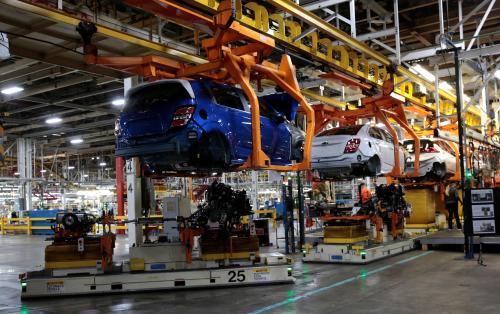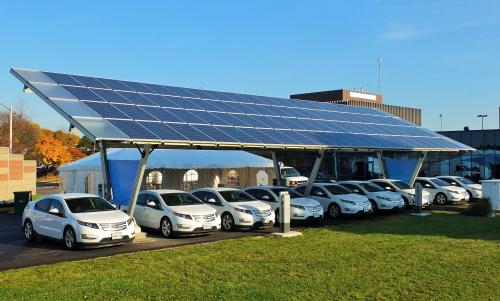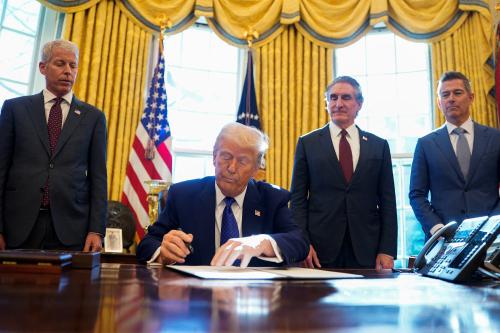This week, the Trump administration issued a Notice of Proposed Rulemaking (NPRM) which, if finalized, would cast aside the commitment made by President Bush and President Obama to increase fuel economy and reduce pollution. In doing so, the administration is on a path that could needlessly upend a settled regulatory framework that has brought together disparate interests, delivered predictability to automakers, improved cars, and reduced pollution. As such, the proposed new rules run counter to what Ford, General Motors, and others across the industry have consistently advocated. In fact, industry and the state of California appear largely aligned on how to proceed in resetting fuel-efficiency standards, and the only missing player is the Trump administration, despite the president’s prior direction to his team to negotiate.
Given that, it is not too late for federal agencies to course correct and utilize the regulatory process as it was intended: for serious stakeholder dialogue. Accordingly, here are three key points that the needed dialogue must recognize:
1. Abandoning the One National Program framework breaks from the bipartisan history of this program
Congress enacted Corporate Average Fuel Economy (CAFE) standards in 1975 to bolster energy security in the wake of the 1973 oil embargo. President Bush called for their establishment as a national priority in 2007 and worked with Democratic congressional leaders to pass the Energy Independence and Security Act (EISA), which required regulatory increases to fuel economy standards. The progression of fuel-efficiency standards in the Obama administration were part of an overall competitiveness strategy for the auto industry, coming on the back of coordinated actions by the Bush and Obama administrations to rescue the industry. In a historic collaboration between the U.S. Department of Transportation (DOT), the Environmental Protection Agency (EPA), the state of California, auto manufacturers, labor, and the environmental community, the Obama administration announced the “One National Program” for the regulation of cars and trucks in 2009.
None of the diverse stakeholders that supported the One National Program are supportive of the current proposal.
The result was a policy that not only applied to the whole nation—extended from 2011 through 2025—but also streamlined the implementation of statutory authorities under EISA, the Clean Air Act (CAA), and California state law (the state is given unique flexibility under the CAA to establish its own requirements). The current policy has led to regulatory stability, an auto sector boom, increased innovation, and reduced emissions. None of the diverse stakeholders that supported the One National Program are supportive of the current proposal.
2. The administration’s proposal will hurt the U.S. auto industry
The U.S. auto industry represents 3.5 percent of U.S. GDP and is responsible for 7 million direct and indirect American jobs. Freezing the standards will undermine investments by auto manufacturers and their suppliers, harming the competitiveness of the industry going forward. Research shows that when standards are set at aggressive but attainable levels, they immediately spur technological innovation, catalyze competitiveness, and support jobs. For example, a report published last year by Indiana University looking at the impact of fuel-efficiency standards estimated that investment in innovation could increase jobs by between 200,000 and 375,000 in the year 2025, and add between $138 billion to $240 billion in GDP between 2017 and 2025.
Challenging California’s authority under the Clean Air Act would needlessly destabilize the consistency created by a streamlined national program.
In fact, even the administration’s own analysis shows that the proposal will result in fewer labor hours than under the current standards, despite prior arguments that the administration was acting to protect auto jobs. Furthermore, challenging California’s authority under the Clean Air Act would needlessly destabilize the consistency created by a streamlined national program.
3. The administration uses a range of questionable assumptions that defy common sense, especially regarding safety, to justify this proposal
Finally, it bears noting that the administration is breaking with a settled consensus on the relationship between fuel economy and safety, instead claiming that freezing the emissions standards would lead to safer roads and less fatalities. To be sure, safety lies at the center of transportation policy and has been a constant and critically important factor for decisionmakers since the inception of the CAFE program. Because of its vital nature, the dynamic effects of safety and fuel efficiency have been long studied by the DOT and academics.
And yet, a review of the literature calls into question the conclusions reached through this NPRM. This administration argues that freezing standards would improve safety by: (A) reducing the incentive for manufacturers’ to deploy mass reduction technologies as a means to save fuel, claiming that on balance heavier vehicles are safer; (B) limiting the ripple effects of fuel savings, known as the “rebound effect,” wherein consumers drive more because efficient vehicles are cheaper to operate, resulting in more vehicle miles traveled and more crashes; and (C) encouraging more drivers to buy new cars that would cost less.
Analysts will have a field day picking apart the flawed analysis, which relies heavily on new and largely untested modeling techniques for evaluating the elasticity of consumer demand, new car sales, and fleet turnover rates. For example, vehicle weight, while the best researched area of the three safety issues, accounts for just 160 of the 12,700 fatalities that the rule claims to avoid. But at any rate, the administration’s tortured argument paints an outdated picture of mobility options in America, one where consumers make binary choices between cars and trucks, and between buying a new car and nurturing the last years of an aging one. Consumers in metropolitan areas in particular have ever-evolving choices that range from ride-sharing to car-sharing to motor scooters—and these changing mobility patterns carry varying safety risks. Between 2005 and 2016, combined traffic fatalities for motorcyclists, bicyclists, pedestrians, and other non-motorists increased from a quarter to a third of total roadway fatalities.
A truly dynamic approach to the fleet and the safety of travelers would question how sales and fleet composition evolve as consumers make different mobility choices than prior generations. Instead, though, the administration’s new proposal narrowly applies factors like outdated rebound effect assumptions to skew the analysis toward an outcome consistent with deregulatory zealotry but inconsistent with a changing reality.
A path forward?
In sum, the nation’s successful fuel-efficiency framework of the last decade has been built on bipartisan, multi-stakeholder dialogue that debated differences, found solutions, and converged around the One National Program. In that spirit, a negotiated solution for the next era would retain steady increases in standards going beyond 2025, incentivize innovation throughout the industry, ensure vehicle safety, help consumers, and protect the environment. The federal rule-making process is built for such an approach, but only if federal agencies get serious and return to the negotiating table.
The Brookings Institution is committed to quality, independence, and impact.
We are supported by a diverse array of funders. In line with our values and policies, each Brookings publication represents the sole views of its author(s).








Commentary
The Trump administration’s fuel-efficiency proposal is unnecessary and harmful
August 3, 2018